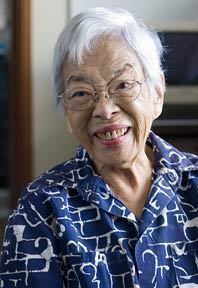Name Isabella Abbott | Role Educator | |
 | ||
Books Taxonomy of Economic Seaweeds: With Reference to Some Pacific and Caribbean Species | ||
Dr isabella abbott aha i olelo ola 12 13 2010
Isabella Aiona Abbott (June 20, 1919 – October 28, 2010) was an educator and ethnobotanist from Hawaii. The first native Hawaiian woman to receive a PhD in science, she became the leading expert on Pacific algae.
Contents
- Dr isabella abbott aha i olelo ola 12 13 2010
- Tribute to dr isabella abbott
- Early life
- Career
- Death
- Works
- References
Tribute to dr isabella abbott
Early life
Abbott was born Isabella Kauakea Yau Yung Aiona in Hana, Maui, Territory of Hawaii, on June 20, 1919. Her Hawaiian name means "white rain of Hana" and was known as "Izzy". Her father was ethnically Chinese while her mother's ancestry was predominantly Native Hawaiian. Her mother taught her about edible Hawaiian seaweeds.
She grew up in Honolulu, and graduated from Kamehameha Schools in 1937. She received her undergraduate degree in botany at the University of Hawaii at Mānoa in 1941, a master's degree in botany from the University of Michigan in 1942, and a Ph.D from the University of California, Berkeley in 1950. She married zoologist Donald Putnam Abbott (1920–1986), who had been a fellow student at the University of Hawaii as well as Berkeley. The couple moved to Pacific Grove, California where her husband taught at the Hopkins Marine Station run by Stanford University. Since at that time women were rarely considered for academic posts, she spent time raising her daughter Annie Abbott Foerster, while studying the algae of the California coast. She adapted recipes to use the local Bull Kelp (Nereocystis) in foods such as cakes and pickles.
Career
In 1960 she started teaching summer classes as a lecturer at Hopkins. She compiled a book on Marine algae of the Monterey peninsula, which later was expanded to include all of the California coast. In 1972 Stanford took the unusual step of promoting her directly to a full professor. In 1982 both Abbotts retired and moved back to Hawaii, where she was hired by the University of Hawaii to study ethnobotany, the interaction of humans and plants.
She authored eight books and over 150 publications. She was considered the world's leading expert on Hawaiian seaweeds, known in the Hawaiian language as limu. She was credited with discovering over 200 species, with several named after her, including the Rhodomelaceae family (red algae) genus of Abbottella. This has earned her the nickname "first lady of limu".
In 1997 she received the Gilbert Morgan Smith Medal from the National Academy of Sciences. In 2008 she received a lifetime achievement award from the Hawaii Department of Land and Natural Resources for her studies of coral reefs.
She was the G. P. Wilder Professor of Botany from 1980 until her retirement, and then was professor emerita of Botany at the University of Hawaii. She served on the board of directors of the Bernice P. Bishop Museum. In November 1997 she co-authored an essay in the Honolulu Star-Bulletin criticizing the trustees of Kamehameha Schools, which led to its reorganization.
In 2005, she was named a Living Treasure of Hawai'i.
Death
Isabella Kauakea Aiona Abbott died at October 28, 2010 at the age of 91 at her home in Honolulu.
Abbott's surviving family includes a daughter who resides in Hawaii and a granddaughter who lives in Hawaii.
To preserve Abbott's legacy and career as a botanist, the University of Hawaii established a foundation to support research on Hawaiian ethnobotany and marine botany.
